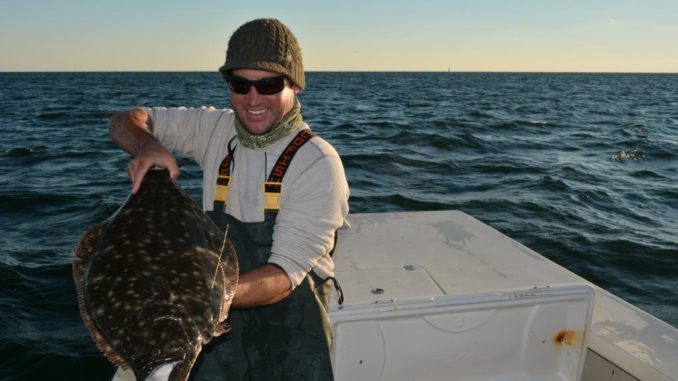
Study will look at flounder movements and mortality in New River between Jacksonville and Sneads Ferry
This summer, a research team from UNC-Wilmington and N.C. State will begin a second study on the movement of southern flounder, funded by a $150,000 grant from Coastal Recreational Fishing License funds to study.
Fred Scharf of UNCW and Jeff Buckel and Joe Hightower of N.C. State will begin tagging flounder in the New River between Jacksonville and Sneads Ferry to determine movement patterns and estimate mortality. The study is for a 4-year period, and data generated will be incorporated into stock assessments for the species.
The study will use tail loop tags externally and acoustic telemetry (sonic) tags that will be implanted in the stomach cavity of 80 flounder each year. The acoustic telemetry tags have a battery life of a year, so they should transmit data through the winter and the spring after their deployment. Each tag will “ping” at a different rate to identify individual fish and track their movements as they swim past sensors located throughout the New River and its tributary creeks. The initial information will be on how and when flounder move within the river system, plus learning more about how much time flounder spend in different areas.
The second part of this study deals with mortality, both from fishing and from natural causes. With the combination of tags, there should be enough data to differentiate between flounder that die in the river, flounder that swim out of the river and flounder that are caught and carried out.
Tail loop tags were chosen to be different from standard external tags so they catch the attention of fishermen. Each tag will carry a telephone number and instructions for collecting a $100 reward for verifying where and when the fish was caught. Fishermen will be allowed to keep the tagged flounder as long as they meet or exceed the minimum length and don’t put the fisherman over his limit. It is very critical to this study that fishermen report caught fish, so the reward was set high enough to get their attention and cooperation.
“The amount and speed of movement will tell us what is happening,” Scharf said. “If a tag doesn’t show movement for a long period of time, or if a tag moves faster but stays in the river, we can assume the first flounder died from natural causes and the second from being eaten by a larger predator that swims faster.
“We have data on the average rates of movement for flounder, so we know movement speeds that would indicate their being eaten. By relating missing fish to the last recorded speed of their tags, we can separate natural mortality from emigration. It isn’t foolproof, but the receivers we are using to track these fish are strong and we should be able to detect fish leaving on their own.”
Scharf said that in addition to the passive tracking of flounder as they swim past sensors, the study will occasionally employ a boat fitted with a strong sensor to scour the river and actively track flounder that might be between sensors.
Scharf is heading up another New River flounder study that is entering its third year, using geo-location archival tags to track flounder migration dynamics through movement, pathways and timing. It was also funded by a CRFL Grant, and 50 flounder have been outfitted with archival tags.
Like the sonic tags, the archival tags must be surgically implanted in the flounder’s stomach cavity. The archival tags are small cylinders with a sensor wire on one end. The sensor wire will be positioned to poke though the flounder’s body in the ribs, behind the gill cover and under the pectoral fin on the dark side. The archival tag is implanted through a small cut on the flounder’s white side.
A tail-loop tag also differentiates the flounder with archival tags as special fish. The archival tags do not transmit data, but must be recovered and downloaded to retrieve the information. Because these archival tags must be recovered, the tail-loop tags on these fish offer a $200 reward for their return. That will buy a lot of flounder dinners for missing one.
“So far we have only had two of the flounder with archival tags caught and returned,” Scharf said. “One of them never left the New River, but the other went out New River Inlet to approximately 40 feet of water and headed south. It was caught in the ocean just outside the mouth of the Cape Fear River near Southport.”


Be the first to comment